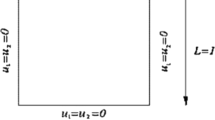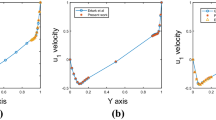Abstract
The objective of this paper is to establish the unconditional stability results of Euler implicit/explicit scheme for the viscoelastic Kelvin–Voigt model with a scalar auxiliary variable. We first reformulate the Kelvin–Voigt model into an equivalent system with three variables. The standard Galerkin finite element method is used to approximate the spatial discretization. Then the Euler implicit/explicit method is adopted to discrete the considered problem, a constant coefficient algebraic system is formed and it can be solved efficiently. The unconditional energy dissipation and stability results of numerical solutions in various norms are established. Optimal error estimates are also presented by the energy method and the Gronwall lemma. Finally, some numerical results are given to verify the established theoretical findings and show the performances of the considered numerical scheme.

Similar content being viewed by others
References
Ammi AA, Marion M (1994) Nonlinear Galerkin methods and mixed finite elements: two-grid algorithms for the Navier–Stokes equations. Numer Math 68:189–213
Bajpai S, Nataraj N (2014) On a two-grid finite element scheme combined with Crank–Nicolson method for the equations of motion arising in the Kelvin–Voigt model. Comput Math Appl 86:2277–2291
Bajpai S, Nataraj N, Pani AK (2013a) On fully discrete finite element schemes for equations of motion of Kelvin–Voigt fluids. Int J Numer Anal Model 10:481–507
Bajpai S, Nataraj N, Pani AK, Damazio P, Yuan JY (2013b) Semidiscrete Galerkin method for equations of motion arising in Kelvin–Voigt model of viscoelastic fluid flow. Numer Methods Partial Differ Equ 29:857–883
Bajpai S, Nataraj N, Pani AK (2014) On a two-grid finite element scheme for the equations of motion arising in Kelvin–Voigt model. Adv Comput Math 40:1043–1071
Dubois T, Jauberteau F, Temam R (1993) Solution of the incompressible Navier–Stokes equations by the nonlinear Galerkin method. J Sci Comput 8:167–194
Frutos JD, Garcia-Archilla B, Novo J (2011) Nonlinear convection–diffusion problems: fully discrete approximations and a posteriori error estimates. IMA J Numer Anal 31:1402–1430
Girault V, Raviart PA (1986) Finite element methods for the the Navier–Stokes equations. Spinger, Berlin
Hansen E, Stillfjord T (2013) Convergence of the implicit-explicit Euler scheme applied to perturbed dissipative evolution equations. Math Comput 82(284):1975–1985
He YN (2008) The Euler implicit/explicit scheme for the 2D time-dependent Navier–Stokes equations with smooth or non-smooth initial data. Math Comput 77(264):2097–2124
He YN (2015) Unconditional convergence of the Euler semi-implicit scheme for the three-dimensional incompressible MHD equations. IMA J Numer Anal 35:767–801
He YN, Li KT (2005) Two-level stabilized finite element methods for the steady Navier–Stokes problem. Computing 74:337–351
He YN, Li J (2010) A penalty finite element method based on the Euler implicit/explicit scheme for the time-dependent Navier–Stokes equations. J Comput Appl Math 235(3):708–725
He YN, Huang PZ, Feng XL (2015) \(H^2\)-stability of first order fully discrete schemes for the time-dependent Navier–Stokes equations. J Sci Comput 62:230–264
Hou T, Shi ZQ (2008) An efficient semi-implicit immersed boundary method for the Navier–Stokes equations. J Comput Phys 227:8968–8991
Kaya S, Rivière B (2006) A two-grid stabilization method for solving the steady-state Navier–Stokes equations. Numer Methods Partial Differ Equ 22:728–743
Ladyzenskaya AP (1969) The Mathematical Theory of Viscous Incompressible Flow. Gordon and Breach, New York
Marti J, Ryzhakov PB (2019) An explicit-implicit finite element model for the numerical solution of incompressible Navier–Stokes equations on moving grids. Comput Methods Appl Mech Eng 350:750–765
Oskolkov AP (1985) Theory of nonstationary flows of Kelvin–Voigt fluids. J Sov Math 28:751–758
Oskolkov AP (1992) On an estimate, uniform on the semiaxis \(t\ge 0\), for the rate of convergence of Galerkin approximations for the equations of motion of Kelvin–Voight fluids. J Sov Math 62:2802–2806
Oskolkov AP, Shadiev RD (1994) Towards a theory of global solvability on \([0,\infty ]\) of initial-boundary value problems for the equations of motion of Oldroyd and Kelvin–Voight fluids. J Sov Math 68:240–253
Pani AK, Pany AK, Damazio P, Yuan JY (2014) A modified nonlinear spectral Galerkin method for the equations of motion arising in the Kelvin–Voigt fluids. Appl Anal 93:1587–1610
Pany AK, Bajpai S, Pani AK (2016) Optimal error estimates for semidiscrete Galerkin approximations to equations of motion described by Kelvin–Voigt viscoelastic fluid flow model. J Comput Appl Math 302:234–257
Rautmann R (1980) On the convergence-rate of nonstationary Navier–Stokes approximations. Approx Methods Navier Stokes Probl 771:425–449
Shen J (1992a) On error estimates of projection methods for Navier–Stokes equations: first-order schemes. SIAM J Numer Anal 29:57–77
Shen J (1992b) On error estimates of some higher order projection and penalty-projection methods for Navier–Stokes equations. Numer Math 62:49–73
Shen J (1996) On error estimates of the projection, methods for the Navier–Stokes equations: second-order schemes. Math Comput 65:1039–1066
Shen J, Xu J (2018) Convergence and error analysis for the scalar auxiliary variable (SAV) schemes to gradient flows. SIAM J Numer Anal 56:2895–2912
Shen J, Xu J, Yang J (2018) The scalar auxiliary variable (SAV) approach for gradient flows. J Comput Phys 353:407–416
Temam R (1984) Navier–Stokes equations, theory and numerical analysis, 3rd edn. North-Holland, Amsterdam
Zhang T, Duan MM (2020) One-level and multilevel space-time finite element method for the viscoelastic Kelvin–Voigt model. Math Methods Appl Sci 43:4744–4768
Author information
Authors and Affiliations
Corresponding author
Additional information
Communicated by Pablo Pedregal.
Publisher's Note
Springer Nature remains neutral with regard to jurisdictional claims in published maps and institutional affiliations.
This work is supported by the NSF of China (no. 11971152) and NSF of Henan Province (202300410167)
Rights and permissions
About this article
Cite this article
Yang, J., Zhang, T. The Euler implicit/explicit FEM for the Kelvin–Voigt model based on the scalar auxiliary variable (SAV) approach. Comp. Appl. Math. 40, 133 (2021). https://doi.org/10.1007/s40314-021-01517-3
Received:
Revised:
Accepted:
Published:
DOI: https://doi.org/10.1007/s40314-021-01517-3
Keywords
- The Kelvin–Voigt model
- Euler explicit/implicit scheme
- Scalar auxiliary variable
- Unconditional stability
- Convergence




